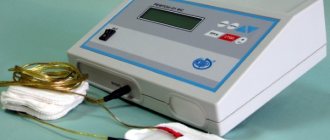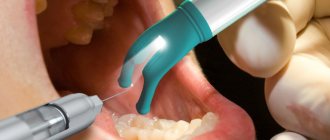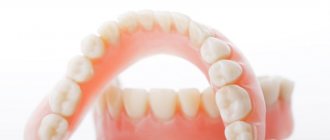From this article you will learn:
- how to improve the fixation of complete removable dentures,
- types of overdentures, reviews,
- price for 2022.
Conditionally removable (covering) dentures are a type of dental prosthetics in the complete absence of teeth, when several dental implants are installed under a removable denture in order to improve its fixation on a toothless jaw. Fixation of such prostheses to implants installed in the bone tissue of the jaws is carried out using special locking fasteners. Such attachments can be push-button or bar-type, for example, through ball-shaped abutments, Locator® equatorial abutments, and cast or milled bars (Fig. 1-3).
Dentures of this type are called “conditionally removable” in dentistry for the reason that you can only remove such a denture if you apply sufficient force. However, patients more often call them by the term “overdentures”. Their biggest advantage is that they never fall off while talking or chewing. It should also be noted that dentures of this type can be used not only with complete, but also sometimes with partial absence of teeth.
Conditionally removable prosthesis: photo
* The minimum cost of a conditionally removable prosthesis on implants will start from 100,000 rubles (detailed options for prostheses and prices - see below).
Advantages of conditionally removable dentures –
Traditional removable dentures made of ordinary acrylic plastic are very poorly fixed on toothless jaws. This is due to the fact that under removable dentures, atrophy of the alveolar processes of the jaws (on which the denture “sits”) gradually occurs. This leads to a gradual decrease in the height and width of the alveolar processes - in proportion to this, the fixation of the prosthesis worsens.
Advantages of dentures on implants -
- excellent fixation even with severe bone atrophy,
- immediate prosthetics,
- comfort - such dentures have a smaller plastic base (on the upper jaw the denture is made with virtually no overlap of the palate),
- relatively affordable price.
Conditionally removable prosthesis on implants: reviews
We have already said above that conditionally removable dentures on implants are fixed using special locking fasteners. Half of each such lock is screwed into the implants and protrudes above the surface of the gum mucosa, and the second half is installed in the base of the denture (in the projection of the installed implants).
When putting on the prosthesis, the parts of the locking fasteners are connected and the prosthesis is securely held. To then remove such a prosthesis, you need to apply a force equal to an approximate lifting of a mass from 400 to 2000 grams (depending on the type of attachment). An overdenture can have several types of fixation to implants, which we will describe in detail below...
Prostheses with push-button fixation –
At the first stage, implants are installed in the jaw, the number of which will depend both on their diameter and on whether prosthetics will be performed on the upper or lower jaw. In the upper jaw, 4 implants are usually installed - regardless of their diameter, which is due to the presence of a softer type of bone in the upper jaw.
On the lower jaw, if mini-implants (1.8-2.4 mm in diameter) are used, 4 of them are also installed. Moreover, the use of implants of such a small diameter allows you to almost always avoid bone grafting - if the patient has thin alveolar shoot. However, if implants with a diameter of 4-5 mm are used, only 2 of them can be installed, but 3-4 are still better, because this will improve the stability of the prosthesis.
Prosthesis fixation system - after installing the implants, abutments are screwed into them, which will protrude above the surface of the mucous membrane and serve as an element for fixing the prosthesis. For these purposes, two types of abutments can be used: spherical or equatorial. Which type of fixation (using which abutments) is better – we explain in detail below.
1) Fixation on ball-shaped abutments –
Below we show a diagram of fixing a removable denture on ball-type abutments. You will find a detailed description below.
After installing the implants, abutments are screwed into them (or the implants may already have permanent abutments). Externally, the spherical abutment looks like a metal ball-shaped head protruding above the mucous membrane (Fig. 4). Such spherical abutments are the first half of the mechanism for fixing a removable denture on implants. The second half of the locking fastening is located in the base of the prosthesis.
In the projection of each implant with a spherical abutment, a recess is made in the base of the prosthesis into which a metal holder for a silicone matrix is inserted, of course, along with the matrix itself. The silicone matrix is something like a rubber sealing ring (Fig. 5). When putting on the prosthesis, the head of the ball-shaped abutment passes through this ring, which then tightly holds the abutment (Fig. 6). After this, the prosthesis can be removed only by applying sufficient force.
Fixation of the prosthesis on ball-shaped abutments: photo
Important: the big disadvantage of the fixation system on ball-shaped abutments is that they tend to wear out as a result of friction in about 2-3 years. As a result, the abutment head becomes flatter and the silicone matrix holds it less and less well. That is why it is worth installing only those implants in which the ball-shaped abutment can be replaced with a new one.
If you install implants that already have permanent abutments, then in order to replace them, you will simply have to install the implants again. To reduce the rate of wear, some companies coat the abutments with special coatings, but this is still not a long-term solution to this problem.
2) Fixation on equatorial abutments (Locator®) –
This fixation system is called Locator® (Fig. 13-15).
For patients, it is more comfortable in terms of removing and putting on a removable denture, and also allows them to visit the dentist less often to service the prosthesis fixation system. It allows implant surgeons to place implants in the jaw at large angles relative to each other, which is necessary in case of severe atrophy of the jaw bone tissue. Equator abutments differ from spherical abutments in their shape, which affects the nature of the interaction between the abutment and the silicone matrix. With this system, a holder for the matrix is also built into the base of the removable denture (along with the silicone matrix itself) - in the projection of each installed implant with an abutment. Equator abutment dentures are more comfortable and require less maintenance.
Fixation of the prosthesis on the equatorial abdomen: photo
Features of prosthetics with prostheses with push-button type of fixation –
The manufacture of a prosthesis, both when using spherical and equatorial abutments, in most cases can be carried out immediately after surgery (especially on the lower jaw). Those. Impressions will be taken immediately and within a few days a prosthesis will be made from either regular acrylic plastic or slightly elastic Acry-free material (this option will be more expensive).
However, if you already have a prosthesis (provided that it is well made and is no more than 2 years old), you will be able to use your old prosthesis without making a new one. To do this, recesses will be made in your old prosthesis and locking fasteners - silicone matrices - will be installed there.
Advantages of push-button type fixation:
- technical ease of manufacture,
- more affordable price,
- implants with push-button fastening can be installed even under an old prosthesis,
- simpler hygiene (less risk of inflammation around implants in the future).
Disadvantages of push-button type locking –
- Weakening of the fixation over time requires periodic replacement of silicone matrices, and in the case of spherical abutments, the matrices will have to be changed several times more often - approximately once every six months (compared to the use of equatorial abutments, where the matrices are changed less frequently).
Overdentures with fixation “Locator”: video
Indications for installation
There are a number of indications for which it is recommended to install telescopic dentures.
- When the number of permanent dental units is insufficient.
- Teeth are unreliable and there is a risk of losing them. Telescopic crowns will perform a protective function.
- Lost teeth can be restored. Dentures will not be visually different from real teeth.
A good option for those patients who want a convenient removable design.
Contraindications
There are some contraindications that also need to be taken into account.
- Abutment teeth are incorrectly positioned.
- Tooth enamel is highly abrasive.
- The periodontium is already in an advanced stage, and the symptoms appear quite clearly.
In addition, sometimes there are pathologies in which it is prohibited to grind teeth. With them, such systems will no longer be suitable.
It is worth paying attention to the cost, it starts from 80 thousand rubles.
Proper care
Proper care of dentures is of great importance. It is imperative to follow all recommendations so that the dentures do not collect dirt and microbes, a pathogenic environment, and the development of carious lesions of the teeth is excluded.
Remember important rules:
- The prosthesis can be used continuously, throughout the day.
- There is no need to place the structure in a glass of water.
- The product is removed in order to completely clean it and carry out thorough hygienic treatment.
- You will need a mirror to carefully remove and put on the prosthesis.
- You should regularly visit a specialist to check the condition of the structure. Then you can quickly repair the prosthesis, eliminate the malfunction, and replace the crowns if the need arises.
- It is best to install and remove the denture in front of the sink. Just send a towel into it first: if the structure falls there, it will remain unharmed.
Be extremely careful to prevent damage to the prosthesis. All hygiene rules must be observed with special care, since it is under such structures that pathogenic environments can develop. In addition, the service life also directly depends on compliance with hygiene and safety rules.
Telescopic dentures will be the optimal solution for replacing lost teeth and protecting existing teeth. They do not interfere with conversation or eating, and they look aesthetically pleasing.
Bar prosthesis on implants –
Covering dentures on implants in the absence of teeth can have not only a push-button type of fixation. In this case, the prosthesis can be fixed on a metal beam secured to 2-4 implants. A recess will be made in the plastic base of the removable denture (corresponding to the size and shape of the metal beam), and silicone holders will be inserted there.
Beam prosthesis on implants: photo
Important: in the upper jaw, only 4 implants should always be installed under the bar structure. This is due to the softer bone of the upper jaw and the high risk of rejection of only 2 implants due to their overload, as well as the fact that the denture on the crown beam will simply balance on it (24stoma.ru). Installing exactly 4 implants will not only extend the durability of the entire structure, but will also significantly increase the stability of the prosthesis and its chewing efficiency.
On the lower jaw, you can make a beam supported by 3 or 4 implants, but the latter option will also be more reliable. Some doctors, seeing that the patient cannot afford to make a prosthesis with this type of fixation on 3-4 implants, make a beam on only 2 implants (installed in the anterior part of the jaw). This, as expected, leads to poor stability of the prosthesis, severe bone atrophy in the lateral parts of the jaw, a high risk of overloading the implants and a low service life of the entire structure.
Important: if you agree to this type of fixation, then the technological method for manufacturing the metal beam will be a very important point. It can be made by casting, welded (welded) from several fragments, or made by milling using CAD/CAM. Ideally, the beam was made using the latter method. And it is especially important that impressions are taken only using the “open impression tray” method (this will ensure accuracy).
Advantages of the beam type of fixation -
- higher chewing efficiency,
- higher stability of the prosthesis,
- Maintenance of the prosthesis fastening system by the dentist is almost not required,
- less risk of implant overload,
- longer service life of the structure.
Disadvantages of the beam type of fixation -
- technically very complex production,
- very high cost,
- higher risk of developing inflammation around implants (due to the need for more careful hygiene),
- you cannot use an old prosthesis,
- if the beam is made on only 2 implants – poor stability of the prosthesis + severe bone atrophy in the lateral parts of the jaws.
What are the pros and cons of the beam prosthetics method?
A removable orthopedic structure attached to a beam and artificial titanium roots definitely has its advantages, especially over traditional removable models. In this regard, experts in the field of orthopedics highlight the following advantages of the method:
- more reliable fixation than removable models,
- more complete restoration of chewing function, fewer restrictions in food products, including solid ones,
- excellent aesthetic performance due to the concealment of fastenings with artificial gums,
- smaller size and weight compared to traditional removable devices,
- significantly higher level of operating comfort,
- lower cost than non-removable and relatively conditionally removable methods of restoring teeth on implants,
- Easy care and operation - the product does not need to be taken out of your mouth every day.
You always need to weigh the pros and cons before making a decision
. As for the disadvantages, here we can highlight the presence of absolute contraindications to the implantation of titanium screws, as well as the rather high cost of treatment compared to the installation of traditional removable solutions. In addition, conditionally removable prosthetics require regular replacement of the orthopedic structure as it wears out, and this usually happens every 5 years.
Covering denture: price 2022
How much does a covering prosthesis cost? The prices below are indicated on a turnkey basis for 2021 (in economy-class and mid-price clinics). The price of the prosthesis will primarily depend on the type of fixation, as well as the number of implants installed.
- Prosthesis on 4 mini-implants Osstem (Korea) with fixation on spherical abutments - the price will be from 100,000 rubles.
- Prosthesis on 2 MIS implants (Israel) with fixation on ball-shaped abutments - price from 110,000 rubles.
- Prosthesis on 2 AstraTech implants (Sweden) with fixation system Locator® – from 140,000 rubles.
- Prosthesis on 2 Straumann implants (Switzerland) with Locator® system fixation – price from 160,000 rubles.
- Beam-type prosthesis on 4 Roott-Form implants (Switzerland) – price from 280,000 rubles.










